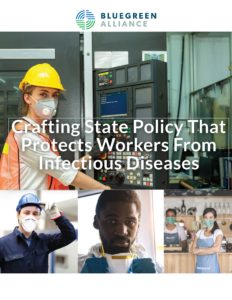Crafting State Policy That Protects Workers From Infectious Diseases – A Policy Toolkit
This toolkit is intended to represent policy responses to COVID-19 that can help workers affected by the coronavirus, using examples drawn from state executive orders and legislation.
This toolkit highlights policy response in four key areas: enacting state-level workplace health and safety standards to protect workers from being infected by COVID-19; protecting workers from retaliation if they refuse unsafe work or report dangerous conditions; ensuring that affected workers are financially protected through worker’s compensation and unemployment insurance; and collecting actionable information about the pandemic from workplaces.
The realities of the coronavirus pandemic are stark, and many workers remain vulnerable to this disease, especially workers of color. Workers of color have seen disproportionately higher rates of illness and death related to COVID-19, and recent information demonstrates that Black and Latinx workers are far more likely to report losing their jobs because of the Covid pandemic.
In some cities, black residents account for about 25% of the population, but 70% of the deaths from COVID-19. This tragic pandemic has occurred at a time of unprecedented administrative failures at the federal level. The Trump administration’s Occupational Safety and Health Administration (OSHA), the federal agency charged with protecting American workers from unsafe workplaces, has declined to issue an emergency health and safety standard to protect workers from contracting COVID-19. Early on in the pandemic, OSHA even issued official guidance stating that it would not respond to most Covid-related safety complaints from workers, ensuring that OSHA would not intervene to make workplaces safer.
Many states have now begun the process of reopening businesses after the shutdowns of March-May 2020. But these reopening efforts have often been driven by public pressure, not by epidemiological data. As a result, reopening without having protections in place to protect workers from infection will force workers to choose between their job and their health. States can act now to ensure that reopening efforts do not place workers at increased risk.Some states are already seeing increased rates and there is a very real risk to see more increases in the fall, when a second wave of infections becomes likely, and at a time when precautions are rapidly waning. State policymakers must take action now to protect workers from the virus itself, and from the financial difficulties that come with job loss or reduced hours. This toolkit is intended to represent some of the policy responses that can help workers affected by the coronavirus, using examples drawn from state
